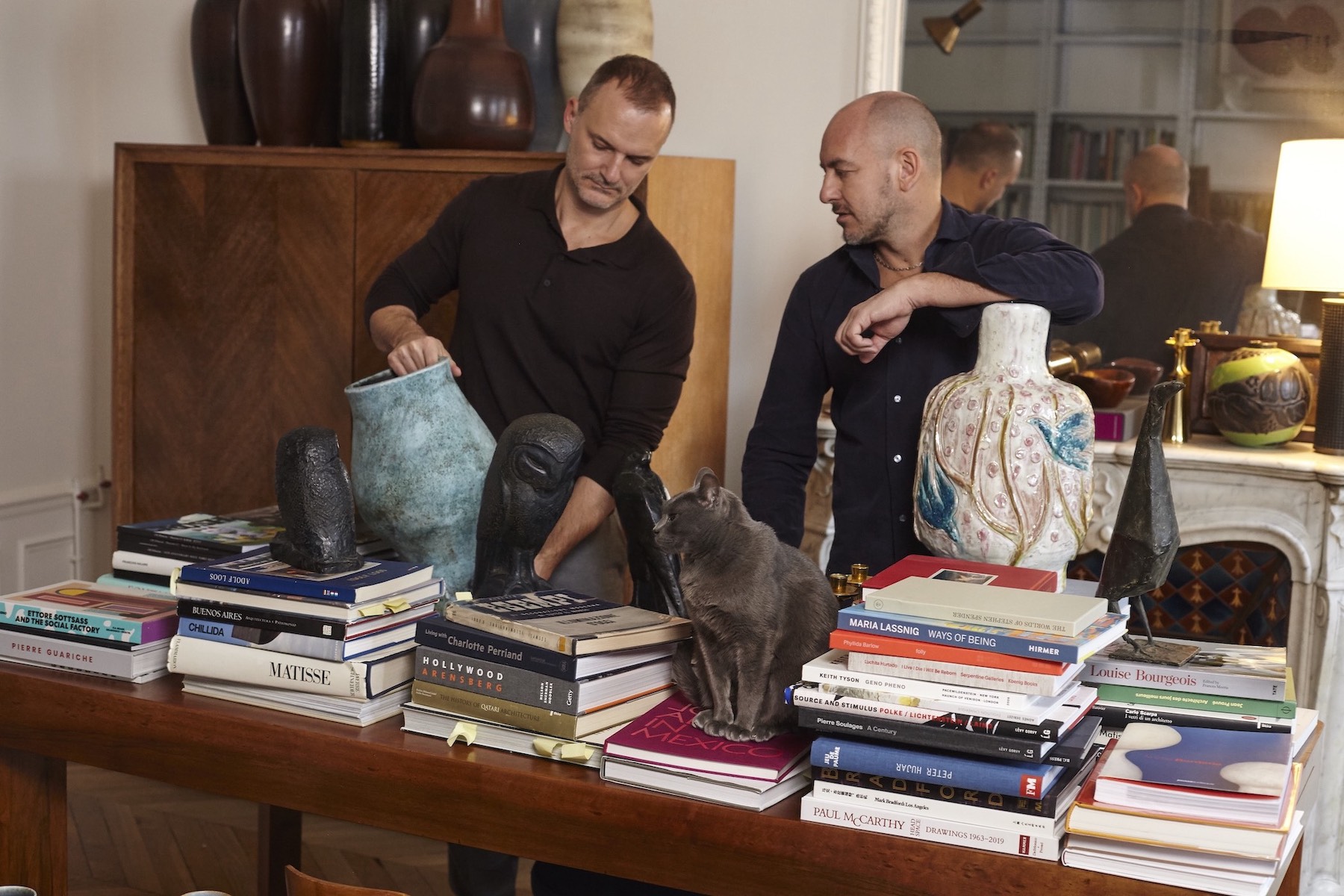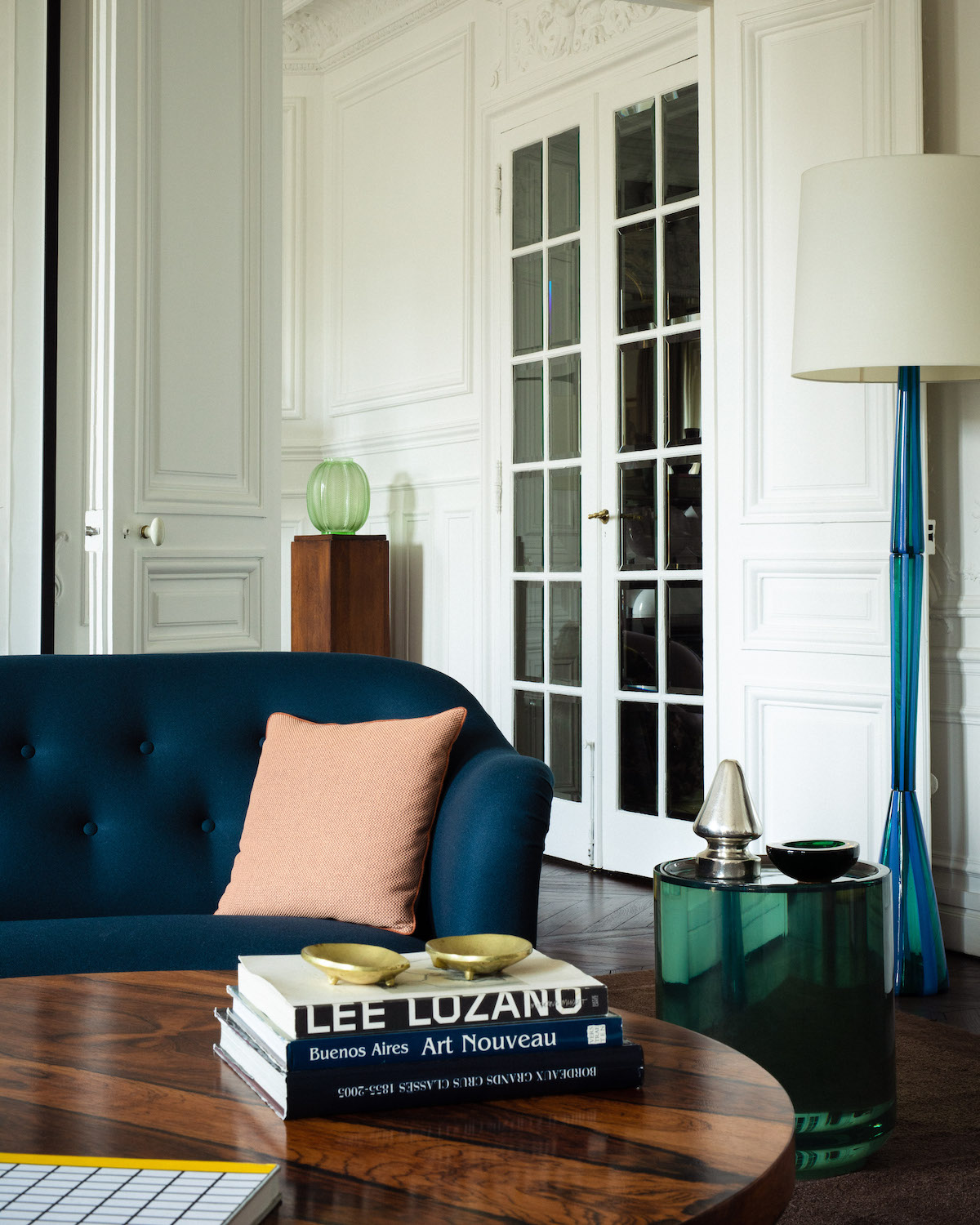The dynamic between Luis Laplace and his life and business partner, Christophe Comoy, is both engaging and charming. Christophe praises Luis’ creative eye and detailed approach to design, while Luis relies upon Christophe’s business acumen and alternative, more analytical viewpoints to allow him to see from a different perspective. Although Luis aims to create spaces that reflect the client, rather than his own style, throughout every commission he prioritises keeping his designs real and honest, which Christophe follows up with a transparent business model. Together, they have worked on projects for the likes of Irwan Wirth, Ursula Hauser, Emmanuel Perrotin, Cindy Sherman and collectors Mick Flick, Nicolas Cattelain, and Adriana Abascal.
LARRY’S LIST had the pleasure of speaking with Luis and Christophe about their complementary approaches to interior design, Luis’ aversion to the term “collector,” their sources of inspiration, and their plans for launching a new furniture line.

9 Questions with Luis Laplace & Christophe Comoy
What is your number one rule when designing a space to best compliment an art collection?
Luis (L): I think that it is very important that a place remains honest. If it’s an existing space, it should remain real and not become a fake place. Everyone has their own vision and their own way of collecting, and this I would always like to reflect in how the collection is shown. In the early 20th Century, people, when they collected, were very messy. They had a lot of things – art, ceramics, furniture, cultural artefacts. Things were very unacademic and very unpredictable. We think this was genuine – it came from the heart. Today, the tendency is to show off. People want to show off the trophy pieces and to show that there is money in each corner. It drives me a bit crazy. Instead, gestures in architecture or in interiors should come naturally with the juxtaposition of all elements, and they should become very personal. People should allow themselves to be different and not to have these formulated spaces with the Jeff Koons or the Kapoor or any other trophy artists.

Do art collectors differentiate from your other clients? How so?
L: I don’t like the word “collector”. Maybe it’s because everyone wants to be a collector because that’s cool and chic and smart. So then you need to be a collector, otherwise it’s like you’re nothing. When you talk to people, everyone today is a collector, but I don’t think that everyone’s a genuine collector. There’s a difference between being a true collector and buying art because you want to live with art in your home.
I think that the most beautiful thing about a collector is that even though some of them are businessmen, many of them are very rational people. Then, when they collect, there’s something about them that becomes very emotional. Why do they have to own something? Why do they have to live with it? That’s difficult to explain in words. But for me, that’s the beauty of it. For true collectors, there’s an obsession that transmits to the whole collection.
When I’m with a client who’s a collector, I’m never the only one giving; it’s an exchange. I always learn a lot from my clients. And it’s always different. Everyone has something to offer. Sometimes I learn from the collection, sometimes I learn from their own vision about the art.
Christophe (C): What is a remarkable about our task and our venture is that we are keeping contact with really exceptional art collectors: people who have been changing the way we see art today, people who have been setting trends like collecting women artists when women artist were not really on the map, or collecting different media. And they don’t like formulas. Our clientele is sophisticated intellectually and culturally, and they cannot be fooled. We bring to them the rigor of a business approach with Luis’ creative eye. Everything must be super transparent.
Are there any artists or pieces of furniture that you get particularly excited about when you see in your clients’ collections (or should we say “assemblies of works”)?
L: In a way, I have something a bit naive in that I try not to think too much about a piece. If it works, we give it the right place. But if a client has a piece very dear to them, we also get excited because that emotion transmits. We try to engage with the emotion of the client.

Do you ever design a space for that “Instagram moment” where everything needs to be perfect, or do you make your interiors adaptable to everyday living?
L: My job is to first help people to cohabitate with their works and that, as a golden rule, is flexible. Today you’re going to have this, but then tomorrow you’re going to have something else. So, I need always to provide flexibility in the space. From a technical point of view, it could be achieved through lighting.
Does it look better when it’s framed on Instagram or in reality? Definitely in reality because the experience is different. Everything is honest. We don’t do an ugly corridor to go to the kitchen because nothing will be there; we make it as interesting as the rest. It has to look real, and real is that things grow naturally. It’s not done today and finished. It grows over the years. I learned this from studying set design in the Teatro Colón in Buenos Aires. Allow for the error and to have the things that are unpredictable. I think these errors are beautiful, and that’s what makes it a home.
With your own interior, particularly your office, we see that it has been shifting or changing quite often with different couches, different side tables, different armchairs.
L: Christophe and myself, we have art, but we’re not art collectors, although we do collect furniture and ceramics. Our home is very dense with ceramics and objects. We like the accumulation of things because we believe in all those dialogues. So, it’s true what you were saying. We change because we like to always be on the move. And we like to test things. There’s always an exchange between Christophe and I. Christophe is a lawyer, and he has a completely different approach than mine. We talk when we play around with the design, and there’s always another view on things. For me, he, in a way, represents a client. He comes from another angle, and his comments are always complementing what I’m not seeing at that time. So, when it comes to furniture, we move things around. We try to do this with art as well, but we do it only once a year.

We noticed in one of your latest Instagram posts that it looks like you are working on some furniture or design objects. Could you tell us about this? Is it a natural development?
C: We have realised that a lot of people are asking for the furniture reserved for our clients – there is a demand. Our ambition would be to offer furniture that we like, that is linked to Laplace and to our universe. But there are a few challenges in making the furniture line. One is to produce affordable products and to make the venture profitable at the same time. So we would have to distribute ourselves. The second thing is that we want to produce as close as possible to where we are based because we want to support the local trades. Also, we have also to take into account the sustainability factor, which is really so important, and to not use plastic or polystyrene for the packaging. We want to offer something that makes people happy and that they like. It should be a nice piece of furniture at a good price. We like things to be functional. We are architects, not artists, and it’s part of our belief that we remain honest, but above everything, we want to remain functional.

What are some of the influences on your work or your major sources of inspiration?
L: More and more, I think that artists and the works of artists are influencing us. We have designed a lot of objects and accessories and things that we put in our projects that oftentimes have close reference to an artist. Not only for objects and spaces, but for shapes, forms and for a lot of things.
Constantin Brancusi is an artist that I am obsessed with. Before the lockdown, I would go every month on a weekend to spend time in his museum in Paris because I’m simply obsessed.
Also, I think that someone like Francis Picabia is so essential. He has a sensual way of showing something, and I like transmitting this into a space as well; it allows us to make a room sensual.
A room can be masculine, feminine, sensual, dry, dense, simple. It can be so many things, so we like to think of all the spaces as being something. This translates to also furniture, to carpets, to colours, to so many things. That’s why I think it’s important that we have no formula. God forbid we ever have one because this bores me to death.
As a tastemaker, are there any trends from your perspective you could share with us? What can we expect to see in your future projects?
C: We love to design gardens, too. I love plants, and Luis loves plants. Sometimes we design houses, and sometimes we also do the garden when it’s simple or doesn’t involve too much expertise. We work with a local gardener who knows the plants, and Luis designs the landscape or the garden. Of course, in a larger-scale project, we definitely need the help of a professional, but it’s something that is extremely important for us. Integrating the local plants and taking into account the local fauna and the insects is, for us, quite important.
Oh… and we are about to design an outdoor gym for our new place in Menorca…

Can you share 5 of your most inspirational IG accounts?
Librairie des Archives
Official free forms NYC
Thibaut Mathieu AD
Areas Vellas
Ronan Bouroullec
All photographs courtesy of Luis Laplace.
Related: Laplace
Instagram: @luislaplace, @comoylaplace
A selection of artists and designers featured in Luis Laplace’s designs:
Constantin Brancusi
Eduardo Chillida
Paul McCarthy
Francis Picabia
By Jamie Bennett






